HEALTH CARE 8 HEALTH CARE Health care Name of the student: Nosocomial Infeasibility in Health Care
VerifiedAdded on 2022/08/20
|11
|3105
|273
Assignment
AI Summary
The systematic review regarding the prevalence of HAI in Australian hospitals from 2010 to 2016 revealed that the incidence of HAI may be about 1, 65, 000 per year. Result: HH and rate of nosocomial infection There were six studies that reported about the effectiveness of hand hygiene compliance on improving rate of nosomial infection. Due to preference for high quality studies, systematic review paper by Andriani & Nadjib (2018) was included in the review as it will gave an overview of findings
Contribute Materials
Your contribution can guide someone’s learning journey. Share your
documents today.
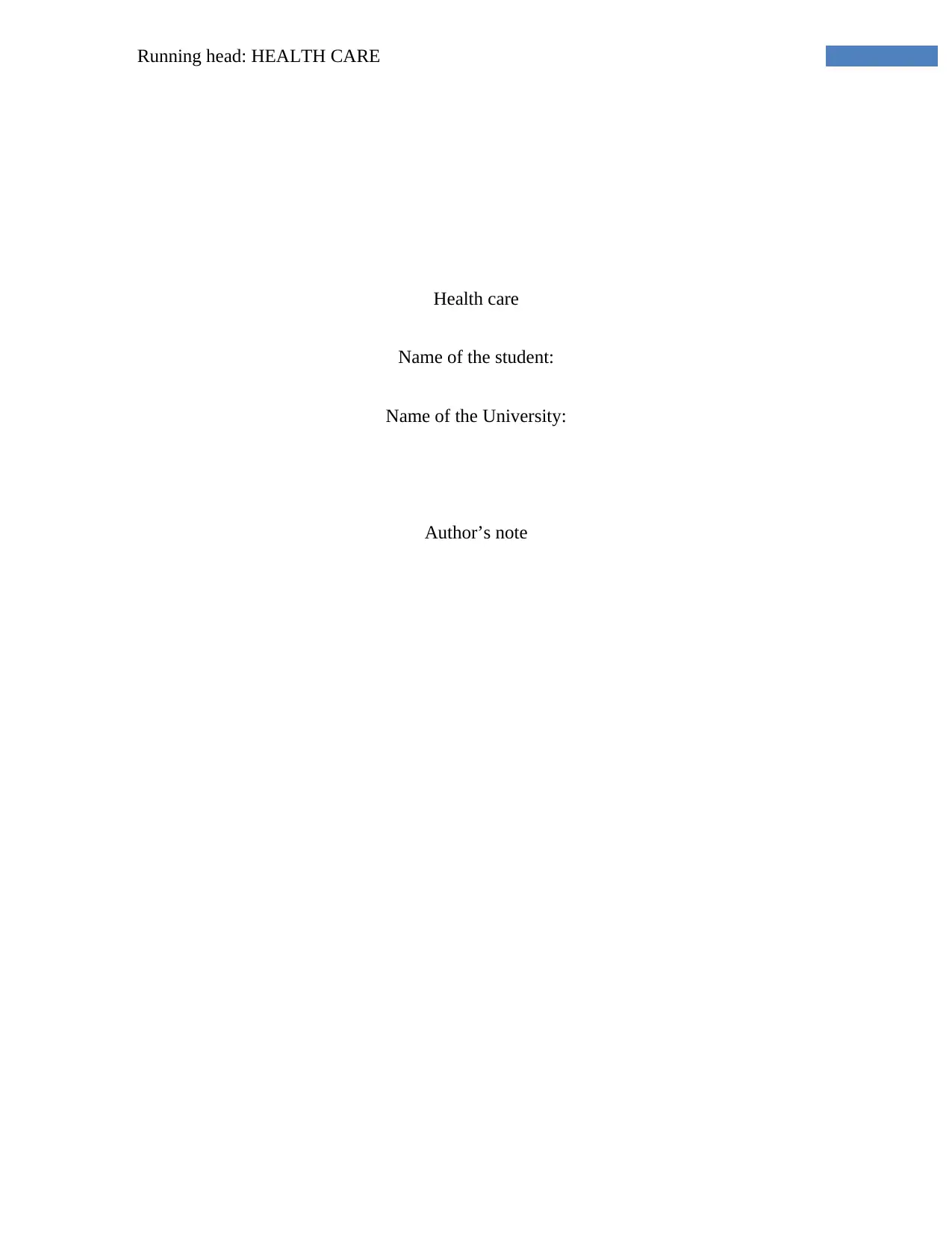
Running head: HEALTH CARE
Health care
Name of the student:
Name of the University:
Author’s note
Health care
Name of the student:
Name of the University:
Author’s note
Secure Best Marks with AI Grader
Need help grading? Try our AI Grader for instant feedback on your assignments.
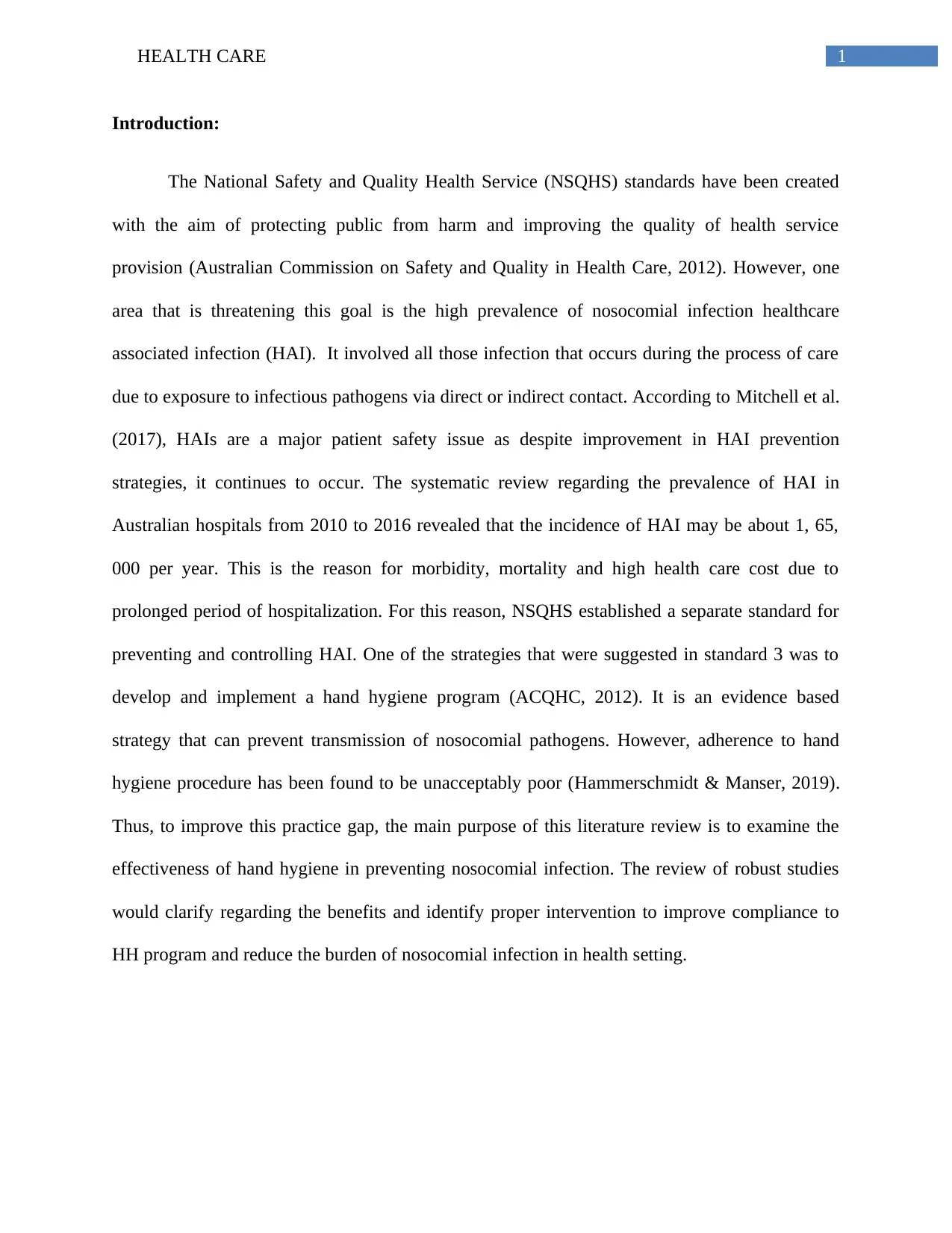
1HEALTH CARE
Introduction:
The National Safety and Quality Health Service (NSQHS) standards have been created
with the aim of protecting public from harm and improving the quality of health service
provision (Australian Commission on Safety and Quality in Health Care, 2012). However, one
area that is threatening this goal is the high prevalence of nosocomial infection healthcare
associated infection (HAI). It involved all those infection that occurs during the process of care
due to exposure to infectious pathogens via direct or indirect contact. According to Mitchell et al.
(2017), HAIs are a major patient safety issue as despite improvement in HAI prevention
strategies, it continues to occur. The systematic review regarding the prevalence of HAI in
Australian hospitals from 2010 to 2016 revealed that the incidence of HAI may be about 1, 65,
000 per year. This is the reason for morbidity, mortality and high health care cost due to
prolonged period of hospitalization. For this reason, NSQHS established a separate standard for
preventing and controlling HAI. One of the strategies that were suggested in standard 3 was to
develop and implement a hand hygiene program (ACQHC, 2012). It is an evidence based
strategy that can prevent transmission of nosocomial pathogens. However, adherence to hand
hygiene procedure has been found to be unacceptably poor (Hammerschmidt & Manser, 2019).
Thus, to improve this practice gap, the main purpose of this literature review is to examine the
effectiveness of hand hygiene in preventing nosocomial infection. The review of robust studies
would clarify regarding the benefits and identify proper intervention to improve compliance to
HH program and reduce the burden of nosocomial infection in health setting.
Introduction:
The National Safety and Quality Health Service (NSQHS) standards have been created
with the aim of protecting public from harm and improving the quality of health service
provision (Australian Commission on Safety and Quality in Health Care, 2012). However, one
area that is threatening this goal is the high prevalence of nosocomial infection healthcare
associated infection (HAI). It involved all those infection that occurs during the process of care
due to exposure to infectious pathogens via direct or indirect contact. According to Mitchell et al.
(2017), HAIs are a major patient safety issue as despite improvement in HAI prevention
strategies, it continues to occur. The systematic review regarding the prevalence of HAI in
Australian hospitals from 2010 to 2016 revealed that the incidence of HAI may be about 1, 65,
000 per year. This is the reason for morbidity, mortality and high health care cost due to
prolonged period of hospitalization. For this reason, NSQHS established a separate standard for
preventing and controlling HAI. One of the strategies that were suggested in standard 3 was to
develop and implement a hand hygiene program (ACQHC, 2012). It is an evidence based
strategy that can prevent transmission of nosocomial pathogens. However, adherence to hand
hygiene procedure has been found to be unacceptably poor (Hammerschmidt & Manser, 2019).
Thus, to improve this practice gap, the main purpose of this literature review is to examine the
effectiveness of hand hygiene in preventing nosocomial infection. The review of robust studies
would clarify regarding the benefits and identify proper intervention to improve compliance to
HH program and reduce the burden of nosocomial infection in health setting.
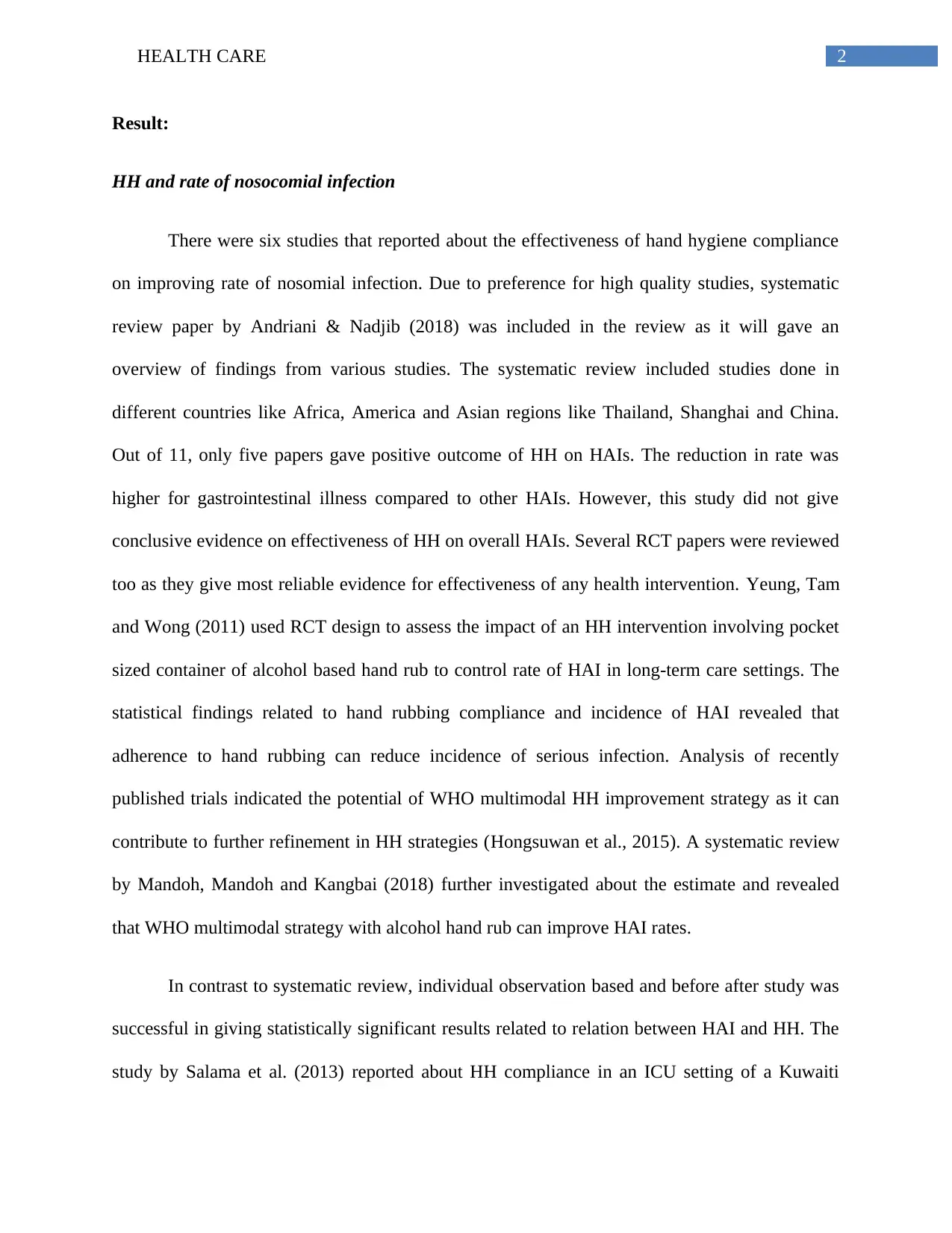
2HEALTH CARE
Result:
HH and rate of nosocomial infection
There were six studies that reported about the effectiveness of hand hygiene compliance
on improving rate of nosomial infection. Due to preference for high quality studies, systematic
review paper by Andriani & Nadjib (2018) was included in the review as it will gave an
overview of findings from various studies. The systematic review included studies done in
different countries like Africa, America and Asian regions like Thailand, Shanghai and China.
Out of 11, only five papers gave positive outcome of HH on HAIs. The reduction in rate was
higher for gastrointestinal illness compared to other HAIs. However, this study did not give
conclusive evidence on effectiveness of HH on overall HAIs. Several RCT papers were reviewed
too as they give most reliable evidence for effectiveness of any health intervention. Yeung, Tam
and Wong (2011) used RCT design to assess the impact of an HH intervention involving pocket
sized container of alcohol based hand rub to control rate of HAI in long-term care settings. The
statistical findings related to hand rubbing compliance and incidence of HAI revealed that
adherence to hand rubbing can reduce incidence of serious infection. Analysis of recently
published trials indicated the potential of WHO multimodal HH improvement strategy as it can
contribute to further refinement in HH strategies (Hongsuwan et al., 2015). A systematic review
by Mandoh, Mandoh and Kangbai (2018) further investigated about the estimate and revealed
that WHO multimodal strategy with alcohol hand rub can improve HAI rates.
In contrast to systematic review, individual observation based and before after study was
successful in giving statistically significant results related to relation between HAI and HH. The
study by Salama et al. (2013) reported about HH compliance in an ICU setting of a Kuwaiti
Result:
HH and rate of nosocomial infection
There were six studies that reported about the effectiveness of hand hygiene compliance
on improving rate of nosomial infection. Due to preference for high quality studies, systematic
review paper by Andriani & Nadjib (2018) was included in the review as it will gave an
overview of findings from various studies. The systematic review included studies done in
different countries like Africa, America and Asian regions like Thailand, Shanghai and China.
Out of 11, only five papers gave positive outcome of HH on HAIs. The reduction in rate was
higher for gastrointestinal illness compared to other HAIs. However, this study did not give
conclusive evidence on effectiveness of HH on overall HAIs. Several RCT papers were reviewed
too as they give most reliable evidence for effectiveness of any health intervention. Yeung, Tam
and Wong (2011) used RCT design to assess the impact of an HH intervention involving pocket
sized container of alcohol based hand rub to control rate of HAI in long-term care settings. The
statistical findings related to hand rubbing compliance and incidence of HAI revealed that
adherence to hand rubbing can reduce incidence of serious infection. Analysis of recently
published trials indicated the potential of WHO multimodal HH improvement strategy as it can
contribute to further refinement in HH strategies (Hongsuwan et al., 2015). A systematic review
by Mandoh, Mandoh and Kangbai (2018) further investigated about the estimate and revealed
that WHO multimodal strategy with alcohol hand rub can improve HAI rates.
In contrast to systematic review, individual observation based and before after study was
successful in giving statistically significant results related to relation between HAI and HH. The
study by Salama et al. (2013) reported about HH compliance in an ICU setting of a Kuwaiti
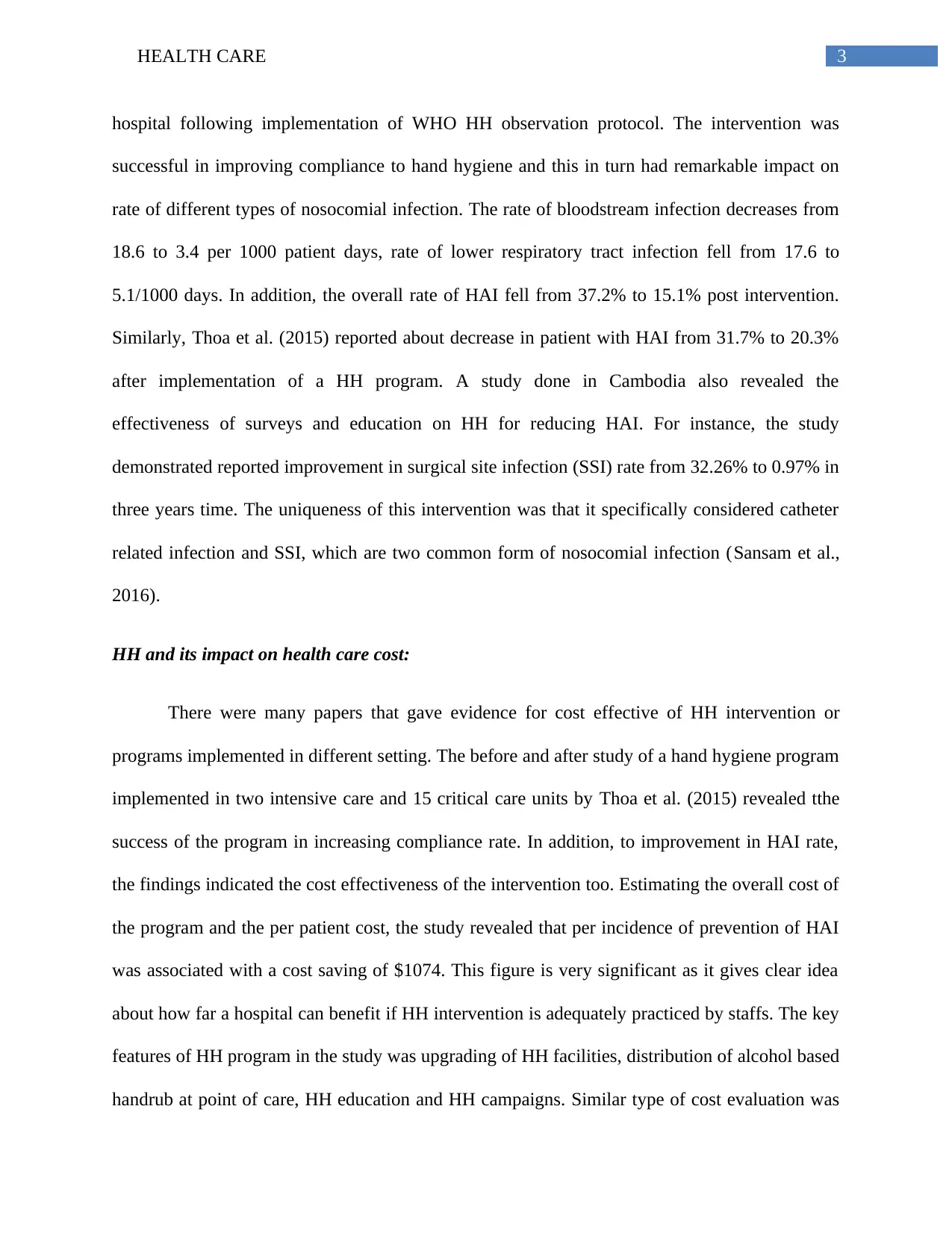
3HEALTH CARE
hospital following implementation of WHO HH observation protocol. The intervention was
successful in improving compliance to hand hygiene and this in turn had remarkable impact on
rate of different types of nosocomial infection. The rate of bloodstream infection decreases from
18.6 to 3.4 per 1000 patient days, rate of lower respiratory tract infection fell from 17.6 to
5.1/1000 days. In addition, the overall rate of HAI fell from 37.2% to 15.1% post intervention.
Similarly, Thoa et al. (2015) reported about decrease in patient with HAI from 31.7% to 20.3%
after implementation of a HH program. A study done in Cambodia also revealed the
effectiveness of surveys and education on HH for reducing HAI. For instance, the study
demonstrated reported improvement in surgical site infection (SSI) rate from 32.26% to 0.97% in
three years time. The uniqueness of this intervention was that it specifically considered catheter
related infection and SSI, which are two common form of nosocomial infection (Sansam et al.,
2016).
HH and its impact on health care cost:
There were many papers that gave evidence for cost effective of HH intervention or
programs implemented in different setting. The before and after study of a hand hygiene program
implemented in two intensive care and 15 critical care units by Thoa et al. (2015) revealed tthe
success of the program in increasing compliance rate. In addition, to improvement in HAI rate,
the findings indicated the cost effectiveness of the intervention too. Estimating the overall cost of
the program and the per patient cost, the study revealed that per incidence of prevention of HAI
was associated with a cost saving of $1074. This figure is very significant as it gives clear idea
about how far a hospital can benefit if HH intervention is adequately practiced by staffs. The key
features of HH program in the study was upgrading of HH facilities, distribution of alcohol based
handrub at point of care, HH education and HH campaigns. Similar type of cost evaluation was
hospital following implementation of WHO HH observation protocol. The intervention was
successful in improving compliance to hand hygiene and this in turn had remarkable impact on
rate of different types of nosocomial infection. The rate of bloodstream infection decreases from
18.6 to 3.4 per 1000 patient days, rate of lower respiratory tract infection fell from 17.6 to
5.1/1000 days. In addition, the overall rate of HAI fell from 37.2% to 15.1% post intervention.
Similarly, Thoa et al. (2015) reported about decrease in patient with HAI from 31.7% to 20.3%
after implementation of a HH program. A study done in Cambodia also revealed the
effectiveness of surveys and education on HH for reducing HAI. For instance, the study
demonstrated reported improvement in surgical site infection (SSI) rate from 32.26% to 0.97% in
three years time. The uniqueness of this intervention was that it specifically considered catheter
related infection and SSI, which are two common form of nosocomial infection (Sansam et al.,
2016).
HH and its impact on health care cost:
There were many papers that gave evidence for cost effective of HH intervention or
programs implemented in different setting. The before and after study of a hand hygiene program
implemented in two intensive care and 15 critical care units by Thoa et al. (2015) revealed tthe
success of the program in increasing compliance rate. In addition, to improvement in HAI rate,
the findings indicated the cost effectiveness of the intervention too. Estimating the overall cost of
the program and the per patient cost, the study revealed that per incidence of prevention of HAI
was associated with a cost saving of $1074. This figure is very significant as it gives clear idea
about how far a hospital can benefit if HH intervention is adequately practiced by staffs. The key
features of HH program in the study was upgrading of HH facilities, distribution of alcohol based
handrub at point of care, HH education and HH campaigns. Similar type of cost evaluation was
Secure Best Marks with AI Grader
Need help grading? Try our AI Grader for instant feedback on your assignments.
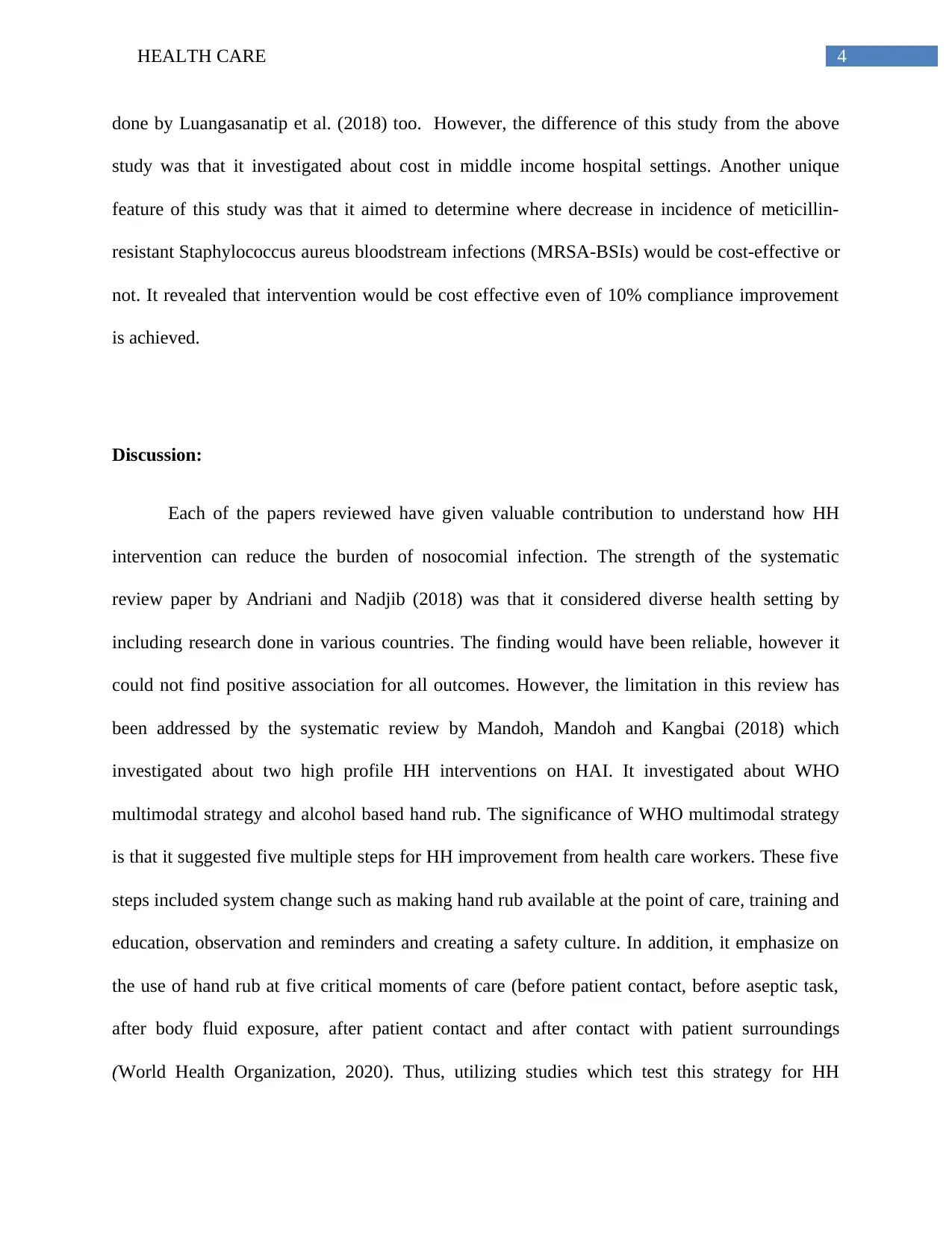
4HEALTH CARE
done by Luangasanatip et al. (2018) too. However, the difference of this study from the above
study was that it investigated about cost in middle income hospital settings. Another unique
feature of this study was that it aimed to determine where decrease in incidence of meticillin-
resistant Staphylococcus aureus bloodstream infections (MRSA-BSIs) would be cost-effective or
not. It revealed that intervention would be cost effective even of 10% compliance improvement
is achieved.
Discussion:
Each of the papers reviewed have given valuable contribution to understand how HH
intervention can reduce the burden of nosocomial infection. The strength of the systematic
review paper by Andriani and Nadjib (2018) was that it considered diverse health setting by
including research done in various countries. The finding would have been reliable, however it
could not find positive association for all outcomes. However, the limitation in this review has
been addressed by the systematic review by Mandoh, Mandoh and Kangbai (2018) which
investigated about two high profile HH interventions on HAI. It investigated about WHO
multimodal strategy and alcohol based hand rub. The significance of WHO multimodal strategy
is that it suggested five multiple steps for HH improvement from health care workers. These five
steps included system change such as making hand rub available at the point of care, training and
education, observation and reminders and creating a safety culture. In addition, it emphasize on
the use of hand rub at five critical moments of care (before patient contact, before aseptic task,
after body fluid exposure, after patient contact and after contact with patient surroundings
(World Health Organization, 2020). Thus, utilizing studies which test this strategy for HH
done by Luangasanatip et al. (2018) too. However, the difference of this study from the above
study was that it investigated about cost in middle income hospital settings. Another unique
feature of this study was that it aimed to determine where decrease in incidence of meticillin-
resistant Staphylococcus aureus bloodstream infections (MRSA-BSIs) would be cost-effective or
not. It revealed that intervention would be cost effective even of 10% compliance improvement
is achieved.
Discussion:
Each of the papers reviewed have given valuable contribution to understand how HH
intervention can reduce the burden of nosocomial infection. The strength of the systematic
review paper by Andriani and Nadjib (2018) was that it considered diverse health setting by
including research done in various countries. The finding would have been reliable, however it
could not find positive association for all outcomes. However, the limitation in this review has
been addressed by the systematic review by Mandoh, Mandoh and Kangbai (2018) which
investigated about two high profile HH interventions on HAI. It investigated about WHO
multimodal strategy and alcohol based hand rub. The significance of WHO multimodal strategy
is that it suggested five multiple steps for HH improvement from health care workers. These five
steps included system change such as making hand rub available at the point of care, training and
education, observation and reminders and creating a safety culture. In addition, it emphasize on
the use of hand rub at five critical moments of care (before patient contact, before aseptic task,
after body fluid exposure, after patient contact and after contact with patient surroundings
(World Health Organization, 2020). Thus, utilizing studies which test this strategy for HH
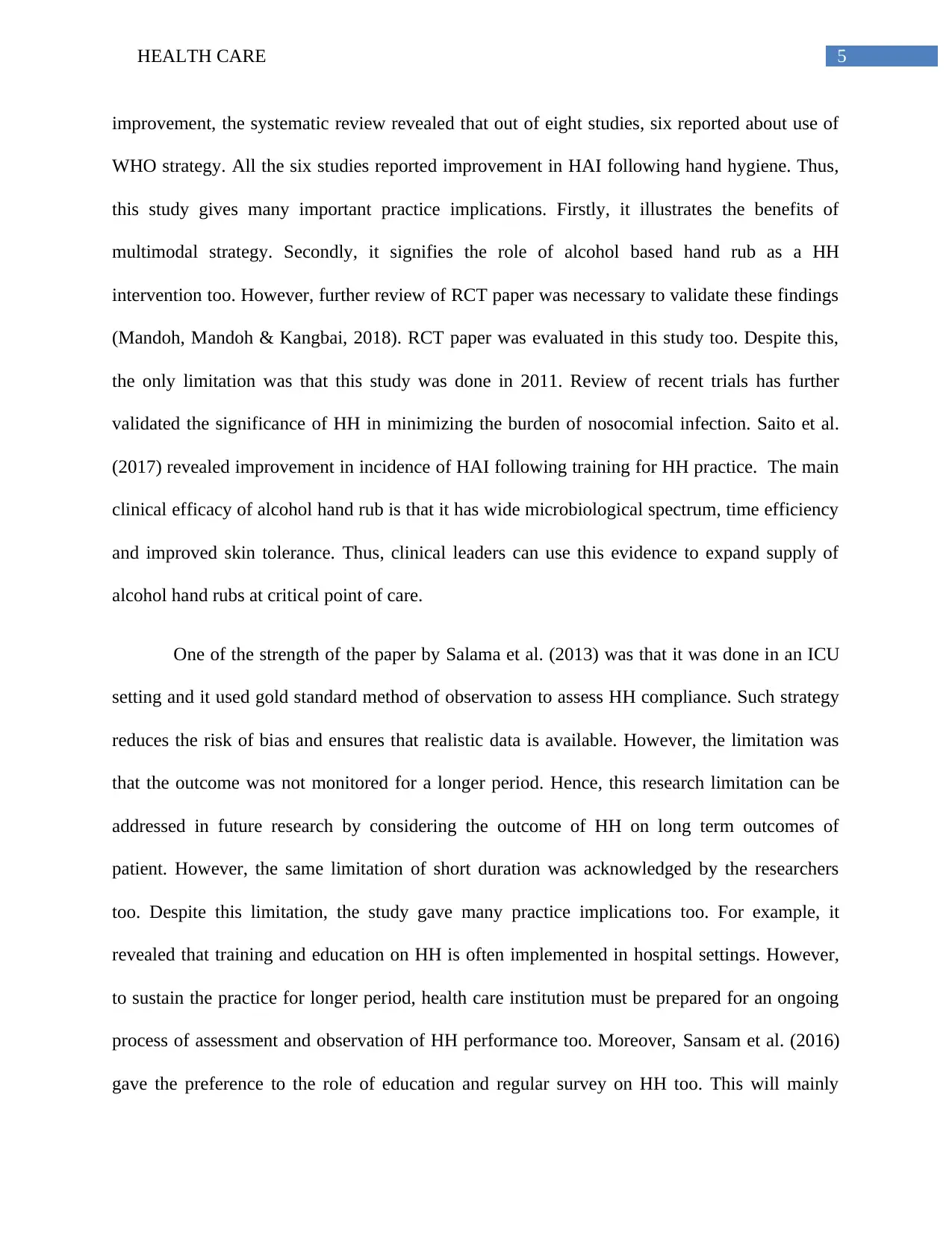
5HEALTH CARE
improvement, the systematic review revealed that out of eight studies, six reported about use of
WHO strategy. All the six studies reported improvement in HAI following hand hygiene. Thus,
this study gives many important practice implications. Firstly, it illustrates the benefits of
multimodal strategy. Secondly, it signifies the role of alcohol based hand rub as a HH
intervention too. However, further review of RCT paper was necessary to validate these findings
(Mandoh, Mandoh & Kangbai, 2018). RCT paper was evaluated in this study too. Despite this,
the only limitation was that this study was done in 2011. Review of recent trials has further
validated the significance of HH in minimizing the burden of nosocomial infection. Saito et al.
(2017) revealed improvement in incidence of HAI following training for HH practice. The main
clinical efficacy of alcohol hand rub is that it has wide microbiological spectrum, time efficiency
and improved skin tolerance. Thus, clinical leaders can use this evidence to expand supply of
alcohol hand rubs at critical point of care.
One of the strength of the paper by Salama et al. (2013) was that it was done in an ICU
setting and it used gold standard method of observation to assess HH compliance. Such strategy
reduces the risk of bias and ensures that realistic data is available. However, the limitation was
that the outcome was not monitored for a longer period. Hence, this research limitation can be
addressed in future research by considering the outcome of HH on long term outcomes of
patient. However, the same limitation of short duration was acknowledged by the researchers
too. Despite this limitation, the study gave many practice implications too. For example, it
revealed that training and education on HH is often implemented in hospital settings. However,
to sustain the practice for longer period, health care institution must be prepared for an ongoing
process of assessment and observation of HH performance too. Moreover, Sansam et al. (2016)
gave the preference to the role of education and regular survey on HH too. This will mainly
improvement, the systematic review revealed that out of eight studies, six reported about use of
WHO strategy. All the six studies reported improvement in HAI following hand hygiene. Thus,
this study gives many important practice implications. Firstly, it illustrates the benefits of
multimodal strategy. Secondly, it signifies the role of alcohol based hand rub as a HH
intervention too. However, further review of RCT paper was necessary to validate these findings
(Mandoh, Mandoh & Kangbai, 2018). RCT paper was evaluated in this study too. Despite this,
the only limitation was that this study was done in 2011. Review of recent trials has further
validated the significance of HH in minimizing the burden of nosocomial infection. Saito et al.
(2017) revealed improvement in incidence of HAI following training for HH practice. The main
clinical efficacy of alcohol hand rub is that it has wide microbiological spectrum, time efficiency
and improved skin tolerance. Thus, clinical leaders can use this evidence to expand supply of
alcohol hand rubs at critical point of care.
One of the strength of the paper by Salama et al. (2013) was that it was done in an ICU
setting and it used gold standard method of observation to assess HH compliance. Such strategy
reduces the risk of bias and ensures that realistic data is available. However, the limitation was
that the outcome was not monitored for a longer period. Hence, this research limitation can be
addressed in future research by considering the outcome of HH on long term outcomes of
patient. However, the same limitation of short duration was acknowledged by the researchers
too. Despite this limitation, the study gave many practice implications too. For example, it
revealed that training and education on HH is often implemented in hospital settings. However,
to sustain the practice for longer period, health care institution must be prepared for an ongoing
process of assessment and observation of HH performance too. Moreover, Sansam et al. (2016)
gave the preference to the role of education and regular survey on HH too. This will mainly
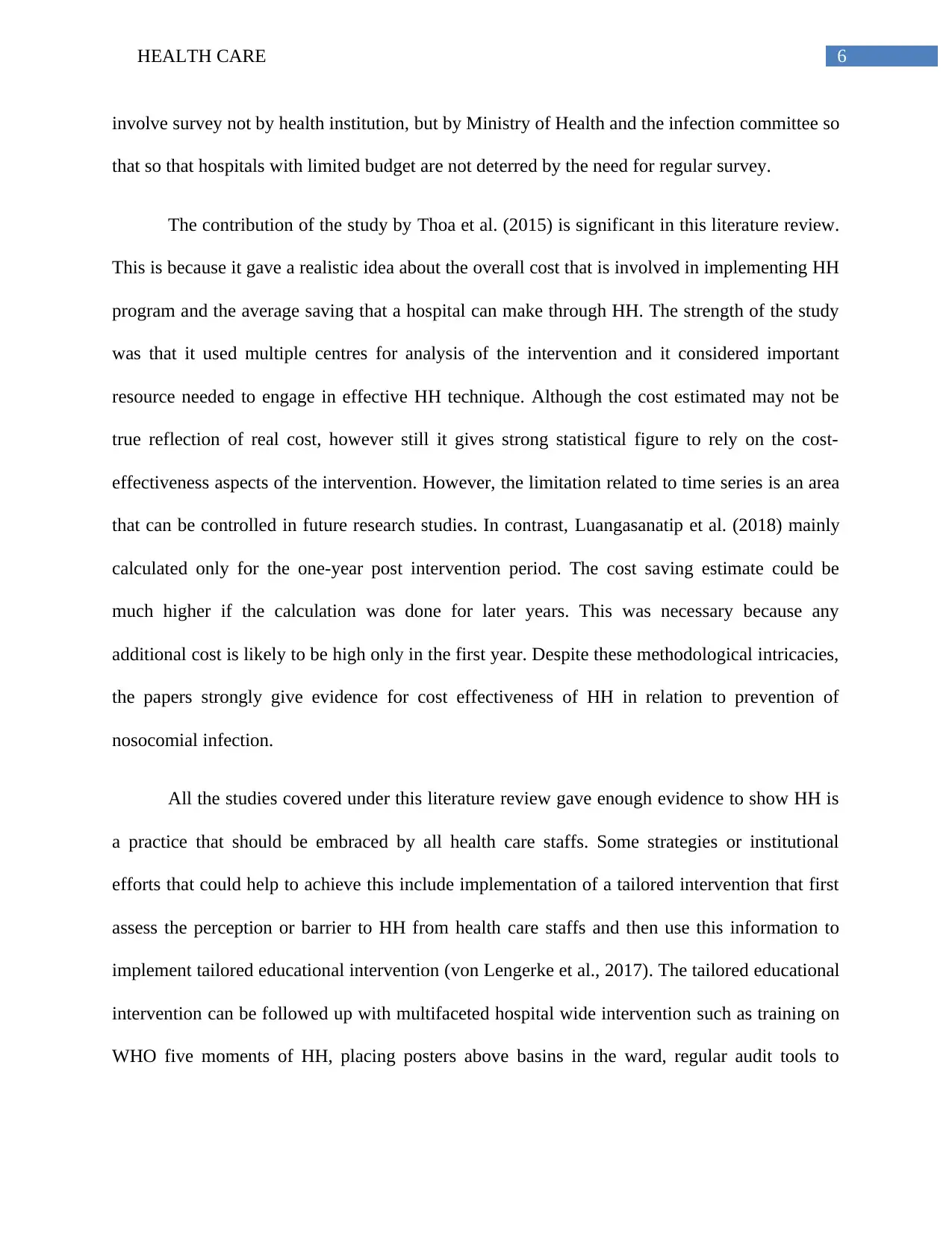
6HEALTH CARE
involve survey not by health institution, but by Ministry of Health and the infection committee so
that so that hospitals with limited budget are not deterred by the need for regular survey.
The contribution of the study by Thoa et al. (2015) is significant in this literature review.
This is because it gave a realistic idea about the overall cost that is involved in implementing HH
program and the average saving that a hospital can make through HH. The strength of the study
was that it used multiple centres for analysis of the intervention and it considered important
resource needed to engage in effective HH technique. Although the cost estimated may not be
true reflection of real cost, however still it gives strong statistical figure to rely on the cost-
effectiveness aspects of the intervention. However, the limitation related to time series is an area
that can be controlled in future research studies. In contrast, Luangasanatip et al. (2018) mainly
calculated only for the one-year post intervention period. The cost saving estimate could be
much higher if the calculation was done for later years. This was necessary because any
additional cost is likely to be high only in the first year. Despite these methodological intricacies,
the papers strongly give evidence for cost effectiveness of HH in relation to prevention of
nosocomial infection.
All the studies covered under this literature review gave enough evidence to show HH is
a practice that should be embraced by all health care staffs. Some strategies or institutional
efforts that could help to achieve this include implementation of a tailored intervention that first
assess the perception or barrier to HH from health care staffs and then use this information to
implement tailored educational intervention (von Lengerke et al., 2017). The tailored educational
intervention can be followed up with multifaceted hospital wide intervention such as training on
WHO five moments of HH, placing posters above basins in the ward, regular audit tools to
involve survey not by health institution, but by Ministry of Health and the infection committee so
that so that hospitals with limited budget are not deterred by the need for regular survey.
The contribution of the study by Thoa et al. (2015) is significant in this literature review.
This is because it gave a realistic idea about the overall cost that is involved in implementing HH
program and the average saving that a hospital can make through HH. The strength of the study
was that it used multiple centres for analysis of the intervention and it considered important
resource needed to engage in effective HH technique. Although the cost estimated may not be
true reflection of real cost, however still it gives strong statistical figure to rely on the cost-
effectiveness aspects of the intervention. However, the limitation related to time series is an area
that can be controlled in future research studies. In contrast, Luangasanatip et al. (2018) mainly
calculated only for the one-year post intervention period. The cost saving estimate could be
much higher if the calculation was done for later years. This was necessary because any
additional cost is likely to be high only in the first year. Despite these methodological intricacies,
the papers strongly give evidence for cost effectiveness of HH in relation to prevention of
nosocomial infection.
All the studies covered under this literature review gave enough evidence to show HH is
a practice that should be embraced by all health care staffs. Some strategies or institutional
efforts that could help to achieve this include implementation of a tailored intervention that first
assess the perception or barrier to HH from health care staffs and then use this information to
implement tailored educational intervention (von Lengerke et al., 2017). The tailored educational
intervention can be followed up with multifaceted hospital wide intervention such as training on
WHO five moments of HH, placing posters above basins in the ward, regular audit tools to
Paraphrase This Document
Need a fresh take? Get an instant paraphrase of this document with our AI Paraphraser
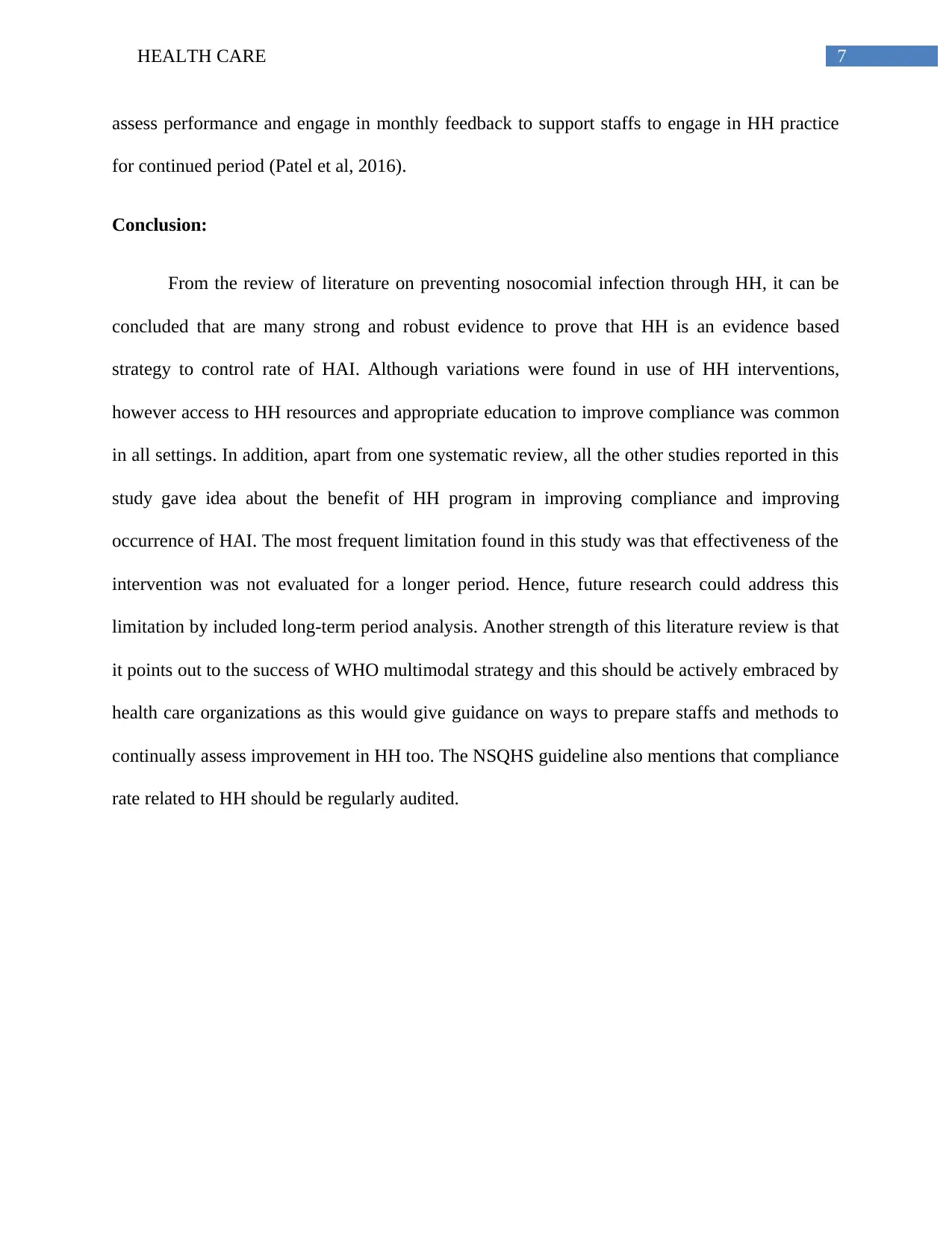
7HEALTH CARE
assess performance and engage in monthly feedback to support staffs to engage in HH practice
for continued period (Patel et al, 2016).
Conclusion:
From the review of literature on preventing nosocomial infection through HH, it can be
concluded that are many strong and robust evidence to prove that HH is an evidence based
strategy to control rate of HAI. Although variations were found in use of HH interventions,
however access to HH resources and appropriate education to improve compliance was common
in all settings. In addition, apart from one systematic review, all the other studies reported in this
study gave idea about the benefit of HH program in improving compliance and improving
occurrence of HAI. The most frequent limitation found in this study was that effectiveness of the
intervention was not evaluated for a longer period. Hence, future research could address this
limitation by included long-term period analysis. Another strength of this literature review is that
it points out to the success of WHO multimodal strategy and this should be actively embraced by
health care organizations as this would give guidance on ways to prepare staffs and methods to
continually assess improvement in HH too. The NSQHS guideline also mentions that compliance
rate related to HH should be regularly audited.
assess performance and engage in monthly feedback to support staffs to engage in HH practice
for continued period (Patel et al, 2016).
Conclusion:
From the review of literature on preventing nosocomial infection through HH, it can be
concluded that are many strong and robust evidence to prove that HH is an evidence based
strategy to control rate of HAI. Although variations were found in use of HH interventions,
however access to HH resources and appropriate education to improve compliance was common
in all settings. In addition, apart from one systematic review, all the other studies reported in this
study gave idea about the benefit of HH program in improving compliance and improving
occurrence of HAI. The most frequent limitation found in this study was that effectiveness of the
intervention was not evaluated for a longer period. Hence, future research could address this
limitation by included long-term period analysis. Another strength of this literature review is that
it points out to the success of WHO multimodal strategy and this should be actively embraced by
health care organizations as this would give guidance on ways to prepare staffs and methods to
continually assess improvement in HH too. The NSQHS guideline also mentions that compliance
rate related to HH should be regularly audited.
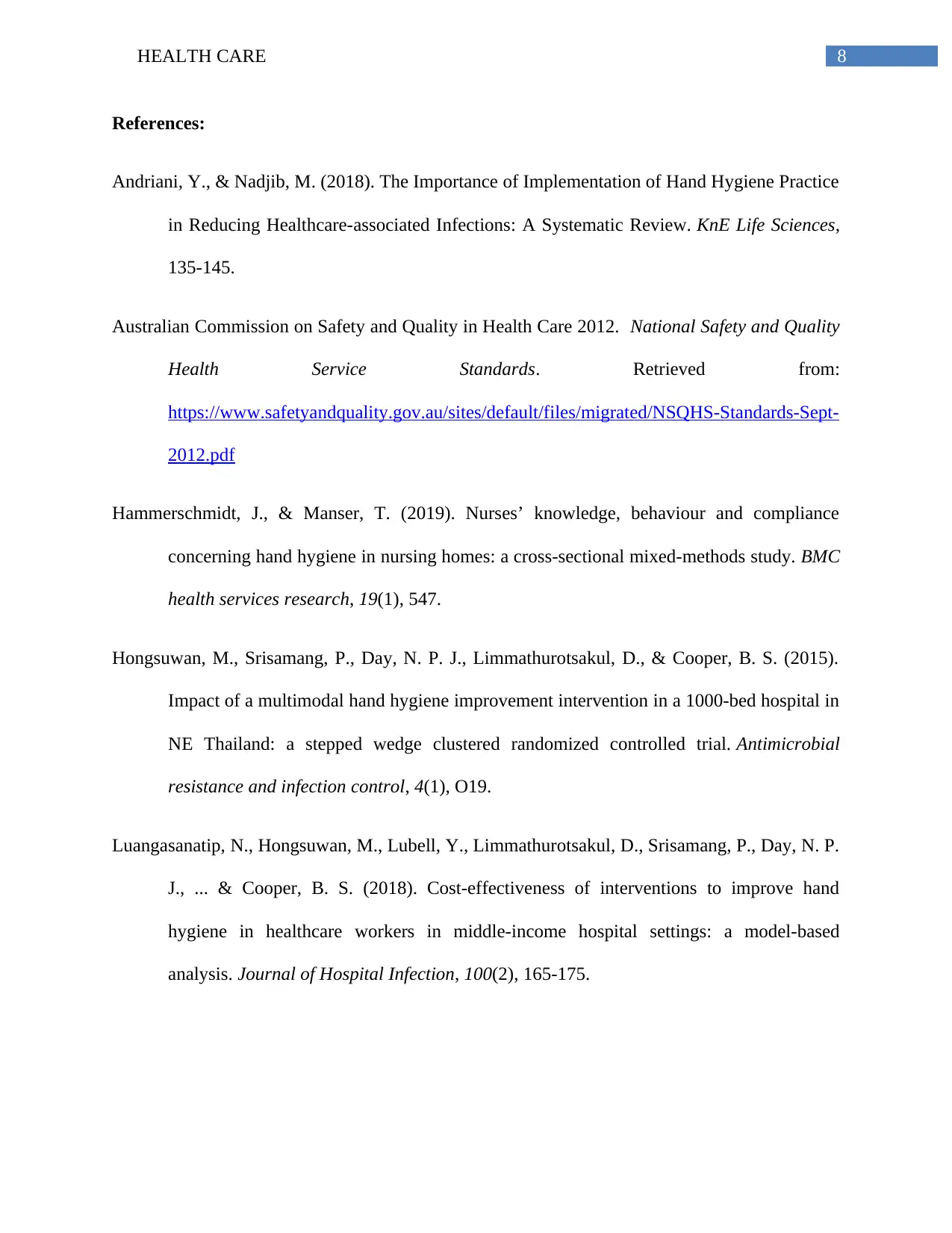
8HEALTH CARE
References:
Andriani, Y., & Nadjib, M. (2018). The Importance of Implementation of Hand Hygiene Practice
in Reducing Healthcare-associated Infections: A Systematic Review. KnE Life Sciences,
135-145.
Australian Commission on Safety and Quality in Health Care 2012. National Safety and Quality
Health Service Standards. Retrieved from:
https://www.safetyandquality.gov.au/sites/default/files/migrated/NSQHS-Standards-Sept-
2012.pdf
Hammerschmidt, J., & Manser, T. (2019). Nurses’ knowledge, behaviour and compliance
concerning hand hygiene in nursing homes: a cross-sectional mixed-methods study. BMC
health services research, 19(1), 547.
Hongsuwan, M., Srisamang, P., Day, N. P. J., Limmathurotsakul, D., & Cooper, B. S. (2015).
Impact of a multimodal hand hygiene improvement intervention in a 1000-bed hospital in
NE Thailand: a stepped wedge clustered randomized controlled trial. Antimicrobial
resistance and infection control, 4(1), O19.
Luangasanatip, N., Hongsuwan, M., Lubell, Y., Limmathurotsakul, D., Srisamang, P., Day, N. P.
J., ... & Cooper, B. S. (2018). Cost-effectiveness of interventions to improve hand
hygiene in healthcare workers in middle-income hospital settings: a model-based
analysis. Journal of Hospital Infection, 100(2), 165-175.
References:
Andriani, Y., & Nadjib, M. (2018). The Importance of Implementation of Hand Hygiene Practice
in Reducing Healthcare-associated Infections: A Systematic Review. KnE Life Sciences,
135-145.
Australian Commission on Safety and Quality in Health Care 2012. National Safety and Quality
Health Service Standards. Retrieved from:
https://www.safetyandquality.gov.au/sites/default/files/migrated/NSQHS-Standards-Sept-
2012.pdf
Hammerschmidt, J., & Manser, T. (2019). Nurses’ knowledge, behaviour and compliance
concerning hand hygiene in nursing homes: a cross-sectional mixed-methods study. BMC
health services research, 19(1), 547.
Hongsuwan, M., Srisamang, P., Day, N. P. J., Limmathurotsakul, D., & Cooper, B. S. (2015).
Impact of a multimodal hand hygiene improvement intervention in a 1000-bed hospital in
NE Thailand: a stepped wedge clustered randomized controlled trial. Antimicrobial
resistance and infection control, 4(1), O19.
Luangasanatip, N., Hongsuwan, M., Lubell, Y., Limmathurotsakul, D., Srisamang, P., Day, N. P.
J., ... & Cooper, B. S. (2018). Cost-effectiveness of interventions to improve hand
hygiene in healthcare workers in middle-income hospital settings: a model-based
analysis. Journal of Hospital Infection, 100(2), 165-175.
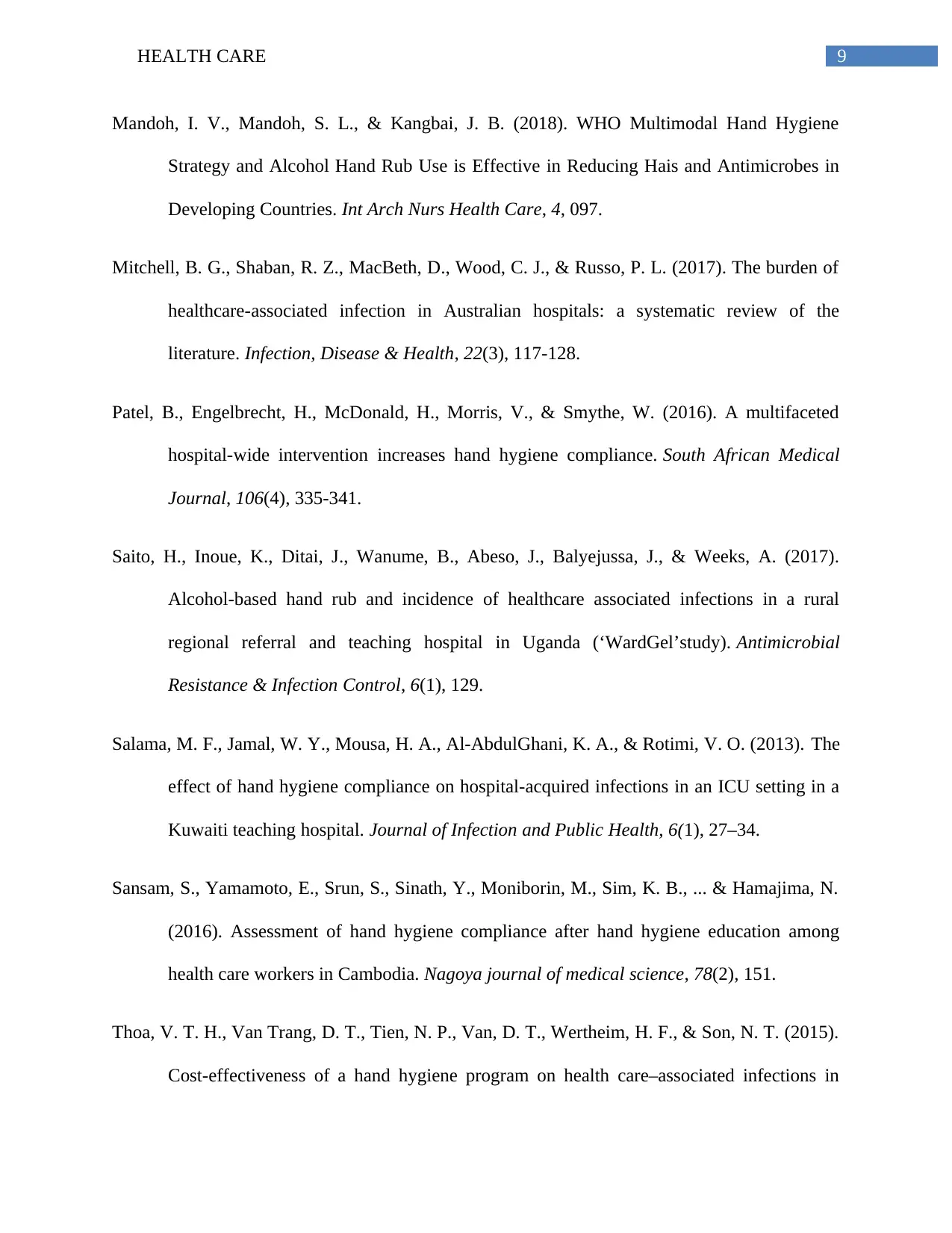
9HEALTH CARE
Mandoh, I. V., Mandoh, S. L., & Kangbai, J. B. (2018). WHO Multimodal Hand Hygiene
Strategy and Alcohol Hand Rub Use is Effective in Reducing Hais and Antimicrobes in
Developing Countries. Int Arch Nurs Health Care, 4, 097.
Mitchell, B. G., Shaban, R. Z., MacBeth, D., Wood, C. J., & Russo, P. L. (2017). The burden of
healthcare-associated infection in Australian hospitals: a systematic review of the
literature. Infection, Disease & Health, 22(3), 117-128.
Patel, B., Engelbrecht, H., McDonald, H., Morris, V., & Smythe, W. (2016). A multifaceted
hospital-wide intervention increases hand hygiene compliance. South African Medical
Journal, 106(4), 335-341.
Saito, H., Inoue, K., Ditai, J., Wanume, B., Abeso, J., Balyejussa, J., & Weeks, A. (2017).
Alcohol-based hand rub and incidence of healthcare associated infections in a rural
regional referral and teaching hospital in Uganda (‘WardGel’study). Antimicrobial
Resistance & Infection Control, 6(1), 129.
Salama, M. F., Jamal, W. Y., Mousa, H. A., Al-AbdulGhani, K. A., & Rotimi, V. O. (2013). The
effect of hand hygiene compliance on hospital-acquired infections in an ICU setting in a
Kuwaiti teaching hospital. Journal of Infection and Public Health, 6(1), 27–34.
Sansam, S., Yamamoto, E., Srun, S., Sinath, Y., Moniborin, M., Sim, K. B., ... & Hamajima, N.
(2016). Assessment of hand hygiene compliance after hand hygiene education among
health care workers in Cambodia. Nagoya journal of medical science, 78(2), 151.
Thoa, V. T. H., Van Trang, D. T., Tien, N. P., Van, D. T., Wertheim, H. F., & Son, N. T. (2015).
Cost-effectiveness of a hand hygiene program on health care–associated infections in
Mandoh, I. V., Mandoh, S. L., & Kangbai, J. B. (2018). WHO Multimodal Hand Hygiene
Strategy and Alcohol Hand Rub Use is Effective in Reducing Hais and Antimicrobes in
Developing Countries. Int Arch Nurs Health Care, 4, 097.
Mitchell, B. G., Shaban, R. Z., MacBeth, D., Wood, C. J., & Russo, P. L. (2017). The burden of
healthcare-associated infection in Australian hospitals: a systematic review of the
literature. Infection, Disease & Health, 22(3), 117-128.
Patel, B., Engelbrecht, H., McDonald, H., Morris, V., & Smythe, W. (2016). A multifaceted
hospital-wide intervention increases hand hygiene compliance. South African Medical
Journal, 106(4), 335-341.
Saito, H., Inoue, K., Ditai, J., Wanume, B., Abeso, J., Balyejussa, J., & Weeks, A. (2017).
Alcohol-based hand rub and incidence of healthcare associated infections in a rural
regional referral and teaching hospital in Uganda (‘WardGel’study). Antimicrobial
Resistance & Infection Control, 6(1), 129.
Salama, M. F., Jamal, W. Y., Mousa, H. A., Al-AbdulGhani, K. A., & Rotimi, V. O. (2013). The
effect of hand hygiene compliance on hospital-acquired infections in an ICU setting in a
Kuwaiti teaching hospital. Journal of Infection and Public Health, 6(1), 27–34.
Sansam, S., Yamamoto, E., Srun, S., Sinath, Y., Moniborin, M., Sim, K. B., ... & Hamajima, N.
(2016). Assessment of hand hygiene compliance after hand hygiene education among
health care workers in Cambodia. Nagoya journal of medical science, 78(2), 151.
Thoa, V. T. H., Van Trang, D. T., Tien, N. P., Van, D. T., Wertheim, H. F., & Son, N. T. (2015).
Cost-effectiveness of a hand hygiene program on health care–associated infections in
Secure Best Marks with AI Grader
Need help grading? Try our AI Grader for instant feedback on your assignments.
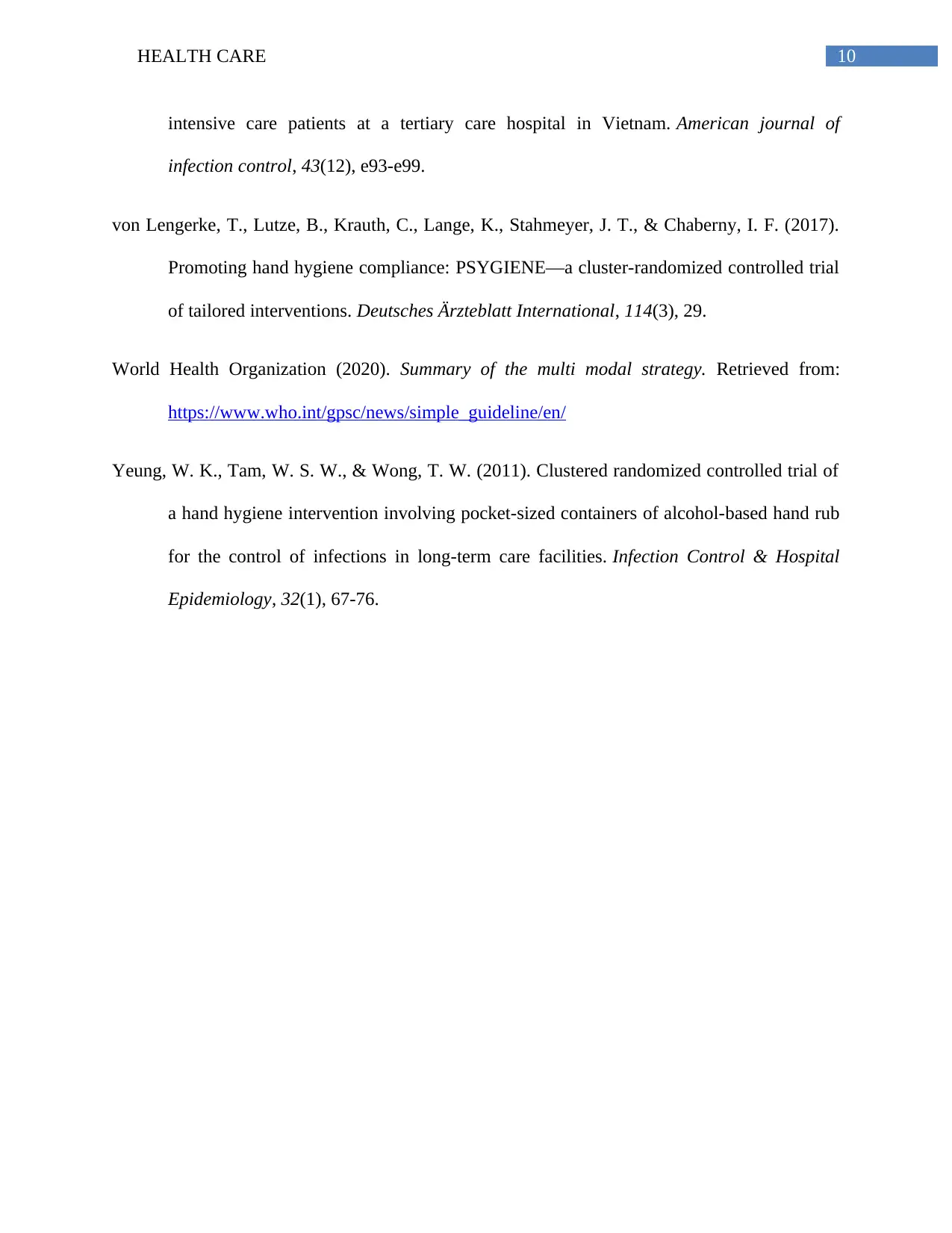
10HEALTH CARE
intensive care patients at a tertiary care hospital in Vietnam. American journal of
infection control, 43(12), e93-e99.
von Lengerke, T., Lutze, B., Krauth, C., Lange, K., Stahmeyer, J. T., & Chaberny, I. F. (2017).
Promoting hand hygiene compliance: PSYGIENE—a cluster-randomized controlled trial
of tailored interventions. Deutsches Ärzteblatt International, 114(3), 29.
World Health Organization (2020). Summary of the multi modal strategy. Retrieved from:
https://www.who.int/gpsc/news/simple_guideline/en/
Yeung, W. K., Tam, W. S. W., & Wong, T. W. (2011). Clustered randomized controlled trial of
a hand hygiene intervention involving pocket-sized containers of alcohol-based hand rub
for the control of infections in long-term care facilities. Infection Control & Hospital
Epidemiology, 32(1), 67-76.
intensive care patients at a tertiary care hospital in Vietnam. American journal of
infection control, 43(12), e93-e99.
von Lengerke, T., Lutze, B., Krauth, C., Lange, K., Stahmeyer, J. T., & Chaberny, I. F. (2017).
Promoting hand hygiene compliance: PSYGIENE—a cluster-randomized controlled trial
of tailored interventions. Deutsches Ärzteblatt International, 114(3), 29.
World Health Organization (2020). Summary of the multi modal strategy. Retrieved from:
https://www.who.int/gpsc/news/simple_guideline/en/
Yeung, W. K., Tam, W. S. W., & Wong, T. W. (2011). Clustered randomized controlled trial of
a hand hygiene intervention involving pocket-sized containers of alcohol-based hand rub
for the control of infections in long-term care facilities. Infection Control & Hospital
Epidemiology, 32(1), 67-76.
1 out of 11
Related Documents
Your All-in-One AI-Powered Toolkit for Academic Success.
+13062052269
info@desklib.com
Available 24*7 on WhatsApp / Email
![[object Object]](/_next/static/media/star-bottom.7253800d.svg)
Unlock your academic potential
© 2024 | Zucol Services PVT LTD | All rights reserved.





